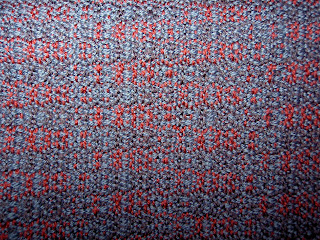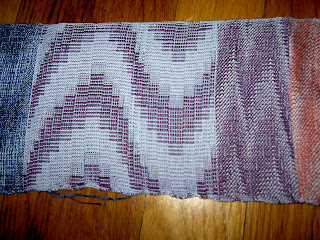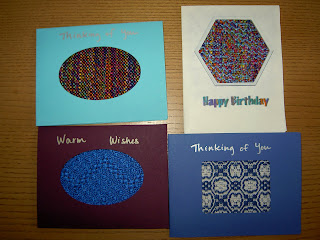I keep hearing about how hot slow art is right now. I think that just about any handweaving and handspinning could be considered slow, but what I'm working on now is ultra-slow! I'm weaving summer and winter bookmarks with 20/2 cotton warp and tabby weft and 10/2 cotton pattern weft on a table loom. It is sett at 36 epi. I chose the table loom for a couple of reasons. First, it's a louet, so it has a raddle that's suited to very fine warp. Second, I like the texsolve heddles for fine warps. If I were to weave this on a floor loom, I would need to use a skeleton tie-up, which would slow down my weaving rhythm considerably, anyway.
This is my first experience with weaving summer and winter. I wanted to make some Christmas gifts, so I designed a draft with little pine trees. I'm thankful to a member of our guild, who put on a program last year about designing with blocks. I had read about this before and vaguely understood how to do it, but to see it explained in person made it much clearer to me. After I had settled on my final design, I was perusing WeaveZine and found a draft there with Christmas trees. I'm glad I found it after I made my own design. While it would have saved me time to use an existing draft, it was good to go through the exercise of designing my own. Besides, I like mine a little better :)
So far, I have one bookmark woven, shown below. It is in the "singles" treadling order, as described by Strickler in her 8-shaft pattern book. My plan is to weave at least one bookmark each in singles, x's, o's, and dukagang-fashion.































 No, I didn't need another wheel. In fact, I've noted an alarming trend: In the three years I've been weaving, I've collected three looms, and in the two years I've been spinning, two wheels. Anyway, my other wheel is an Ashford Joy, which is fabulous for taking places. Recently, I took it on a business trip to relax in the hotel that evening. The Ladybug will be my stay-at-home wheel. She is so stable and smooth, a real pleasure to use. I love that the functionality is similar to that of a Matchless. The only drawback I can find to this wheel is that it's not pretty, like a Matchless. The red plastic isn't traditional, but with my background in materials engineering, I feel almost as if I need to defend the inexpensive but funcitonally similar materials, even if they aren't beautiful.
No, I didn't need another wheel. In fact, I've noted an alarming trend: In the three years I've been weaving, I've collected three looms, and in the two years I've been spinning, two wheels. Anyway, my other wheel is an Ashford Joy, which is fabulous for taking places. Recently, I took it on a business trip to relax in the hotel that evening. The Ladybug will be my stay-at-home wheel. She is so stable and smooth, a real pleasure to use. I love that the functionality is similar to that of a Matchless. The only drawback I can find to this wheel is that it's not pretty, like a Matchless. The red plastic isn't traditional, but with my background in materials engineering, I feel almost as if I need to defend the inexpensive but funcitonally similar materials, even if they aren't beautiful. 




















